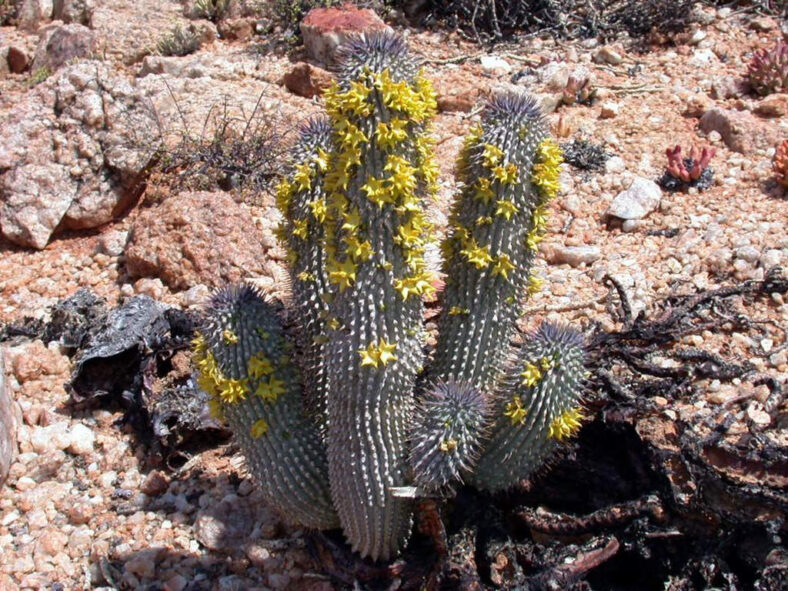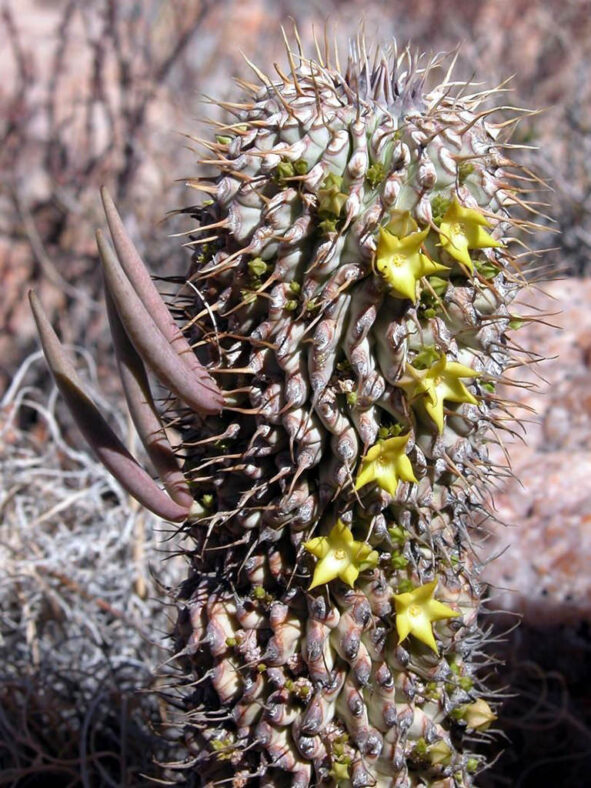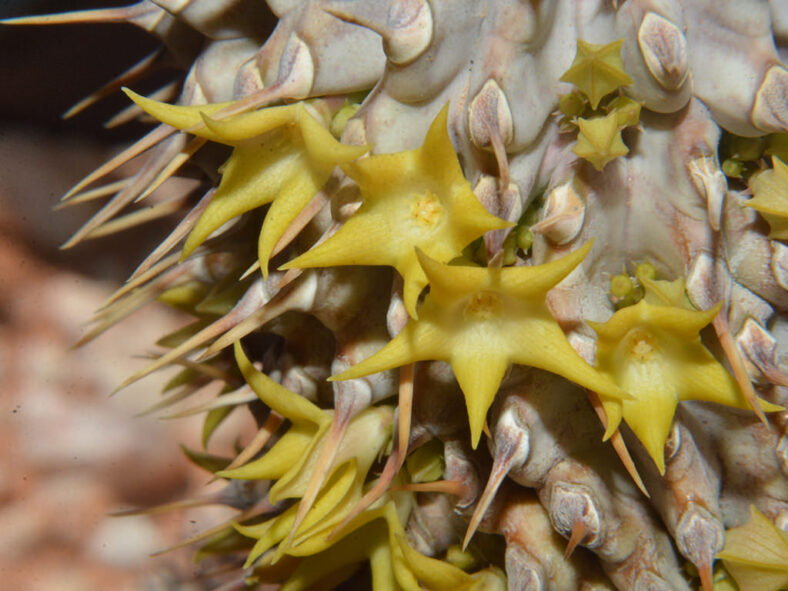Hoodia alstonii is a cactus-like succulent found in Africa, known in Afrikaans as "ghaap." It has been traditionally harvested in the wild as a food source.
Scientific Name
Hoodia alstonii (N.E.Br.) Plowes
Synonym(s)
Ceropegia alstonii, Trichocaulon alstonii
Scientific Classification
Family: Apocynaceae
Subfamily: Asclepiadoideae
Tribe: Ceropegieae
Genus: Hoodia
Etymology
The specific epithet "alstonii" (pronounced "al-STON-ee-eye") honors Edward Garwood Alston (1862-1934), a farm manager and plant collector in the Northern Cape province of South Africa who sent plants to Peter MacOwan and Selmar Schönland.
Origin
The native range of Hoodia alstonii is within the winter-rainfall region of southern Namibia and the western parts of the Northern Cape province of South Africa. It mainly grows on schistous slopes and outcrops, but also occasionally on quartz ridges.
Description
Hoodia alstonii is a succulent shrub with grayish, leafless stems covered with tubercles fused below the middle, creating 20 to 22 obtuse angles along the stem. The cylindrical stems can grow up to 3.3 feet (1 m) tall and 3.2 inches (8 cm) in diameter. Each tubercle is tipped with a stout, sharp, pale brown spine measuring up to 0.4 inches (1 cm) long.
During the spring, Hoodia alstonii produces inflorescences mainly in the upper parts of the stem, with each inflorescence containing 1 to 8 flowers arising from short, thick stalks. The corolla is bell-shaped and can reach a diameter of 0.7 inches (1.8 cm). On the outside, the corolla is pale greenish-yellow to cream, while on the inside, it is bright yellow, fading to a whitish tone towards the base. The corona is pale yellow and raised on a short stipe. The fruits are pairs of pink, fusiform follicles.

How to Grow and Care for Hoodia alstonii
Light: Hoodia alstonii prefers full sun but benefits from light shade on the hottest summer days. Indoors, place the plant near the brightest window in your home, as it will stretch if it does not receive enough sunlight. Avoid abruptly moving a plant adapted to lower light levels to full sun to prevent sunburn.
Soil: Use a commercial potting soil mix designed for succulents or prepare your own by mixing 50% to 70% mineral grit, such as coarse sand, pumice, or perlite.
Temperature: The plant thrives in warm outdoor environments with low to moderate humidity. It does not like winter cold and should remain relatively dry and warm during its dormancy. Hoodia alstonii grows best in USDA Plant Hardiness Zones 10a to 11b, with average minimum winter temperatures ranging from 30 to 50 °F (-1.1 to 10 °C).
Watering: It has typical watering needs for a succulent. During the growing season, from spring to fall, water the plant thoroughly and allow the soil to dry between waterings. When it goes dormant in winter, it needs almost no water, about once a month.
Fertilizing: Feeding is beneficial for keeping this plant healthy and thriving. Use a water-soluble fertilizer diluted to half-strength, but only when the plant is actively growing.
Repotting: Repot Hoodia alstonii in spring, just before the growing season. It has shallow roots and does not require a lot of soil to grow. Always pick a container with drainage holes.
Propagation: The best way to propagate this succulent is by stem cuttings. To ensure good rooting, take cuttings during the growing season. The plant is also easy to start from seeds in spring.
Learn more at How to Grow and Care for Stapeliads.
Toxicity of Hoodia alstonii
Hoodia alstonii is non-toxic and safe to grow around kids and pets.
Links
- Back to genus Hoodia
- Succupedia: Browse succulents by Scientific Name, Common Name, Genus, Family, USDA Hardiness Zone, Origin, or cacti by Genus
Photo Gallery
Click on a photo to see a larger version.


